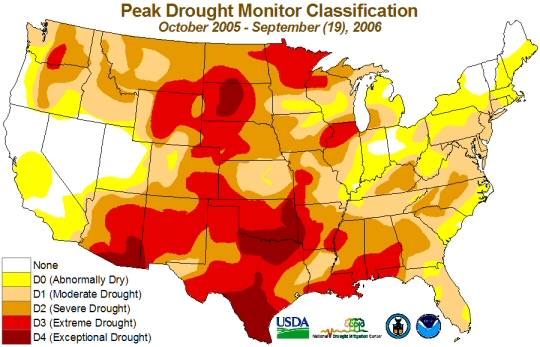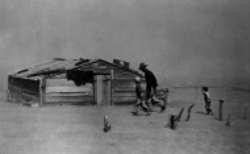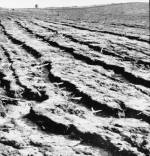 |
 |
| Home | Welcome | What's New | Site Map | Glossary | Weather Doctor Amazon Store | Book Store | Accolades | Email Us |
 | |||||||||||||||
Weather Almanac for July 2007DROUGHT: THE SILENT DISASTER
Long term conditions are not expected to get any better. According to the Intergovernmental Panel on Climate Change (IPCC) 2007 report, significant droughts will be more common in the middle latitudes and the semi-arid low latitudes over the coming decades. Some Basic DefinitionsThe American Meteorological Society Glossary of Meteorology (1959) defined drought as: "a period of abnormally dry weather sufficiently prolonged for the lack of water to cause serious hydrologic imbalance in the affected area." While drought is a normal component of the Earth's climate, its impacts vary among the regions where it is manifest. In general, drought arises from a deficiency of precipitation over an extended period of time, usually a season or more. It is considered a temporary condition that distinguishes it from the arid conditions which are the main climatic factor in several global zones, including the world's permanent deserts. Drought can be seen as an extreme event relative to the region's average precipitation conditions.
The conceptual definitions of drought are composed using general terms for the main purpose of helping people understand the concept. NDMC uses this as an example of a conceptual definition: "Drought is a protracted period of deficient precipitation resulting in extensive damage to crops, resulting in loss of yield." Operational definitions of drought are usually data driven and help identify the beginning, end, and degree of severity of a drought. They specify the degree of departure, over a specified time period, from an average (usually the most recent climate normal) value of precipitation or some similar variable. These definitions are often tied to an effect, such as impacts on agricultural crops. Thus, operational definitions can be categorized as meteorological, hydrological, agricultural, or socioeconomic drought, and the definition parameters are regionally set. The parameters that categorize a drought event under one definition need not define drought conditions under another definition.  Peak Drought Conditions across United States |
|||||||||||||||
 |
Dust Over Dakota.In: To Hold This Soil, Miscellaneous Publication No. 321, |
Hydrological drought will have major socioeconomic impacts through its link with hydroelectric power generation and drinking water supplies. Many hydroelectric generating systems can ride out a short drought through the impoundment of water in large dam reservoirs, but this may only place another time lag into the impacts of a hydrological drought. When hydroelectric generation is reduced due to drought conditions, the electrical grid system must often make up the deficit by burning expensive (economically and environmentally) fossil fuels to met the demand.
While impacts on agriculture, hydroelectric generation and water supply are the most obvious effects of drought, there are many others that are not so obvious to the general public. Transportation links are not obvious victims of drought conditions, but prolonged drought can have major economical impacts on a nation's transportation network.
Prime examples can be seen in North America when drought over their basins produces lower water levels on the Great Lakes–St Lawrence River system and the Missouri–Mississippi River systems. In both systems, low water reduces, and often halts, commercial shipping that is vital to the national economies of the US and Canada. When the waters are low, ships and barges are not able to navigate certain sections of their desired routes, and they must either cease shipping or reduce their cargos to lessen the draft of the vessels.
In 2002, the impacts of diminished water levels on the Great Lakes had a great economic cost according to Helen Brohl, Executive Director of the US Great Lakes Shipping Association. She reported, as an example, that for every 2.5 centimetres (1 inch) of water lost in the level of Lake Michigan below a critical level, a cargo ship must reduce its load by 90 to 115 tonnes (tons) at a loss of between $22,000 and $28,000 US to the carrier. At present (2007), Lake Superior is experiencing extremely reduced lake levels, and its waters feed into the other four Great Lakes. Thus, the region may experience affected shipping for many years to come.
The multi-year drought on the Missouri River basin over the last decade has had impacts on the commerce of that river all the way to the Mississippi and down that river to the Gulf of Mexico. Though smaller in scale than that on the Mighty Mississippi, commercial barge traffic on the Missouri River shrank significantly, — one large company did not run a barge up the river for several years — forcing railroads and trucking to take up the slack.
The impact of lower waters on the Mississippi itself over the last few years has reduced the size and the draft of the great flotillas of barges that carry on average more than 310 million tonnes (tons) of grain, soybeans, corn, petroleum, steel, and ore every year. Not only does the lower water decrease the depth of the river, it also reduces the width of the navigable river.
Under normal operating conditions on the lower Mississippi, barges — each measuring about 35-by-200 feet (10.7 by 61 m) — are lashed together five wide and eight long. A decrease in water level of about a metre (3 feet) results in a reduction of cargo capacity per barge from 900 to 1500 tonnes (tons). In September 2006, river traffic regulators decreased the width of a typical barge flotilla by one string of eight barges. This reduced the capacity of a flotilla by as much as 12,000 tonnes. (For comparison, a tractor-trailer truck rig carries about 26 tonnes (tons).)
Outdoor recreation and tourism may also be significantly affected by drought with considerable economic losses. Though those taking part in outdoor recreation and most tourists generally prefer a sunny, or at least dry, time for their activities, drought can often reduce the enjoyment of that time. Reduced snowpacks for skiers and snowmobilers, reduced lake and river levels for recreational boaters and fishers, threats of wildfires, and effects on wildlife are among the greatest effects on outdoor and tourist activities.
 |
"Fleeing a dust storm". |
Debilitating droughts also hit the US in 1953/54 (Midwest); 1963-1965 (Northeast); 1975-1977 (California); and 1984-1988 (35 States). As of this writing, much of the Western US has seen nearly a decade of dry and drought conditions, with drought conditions now extending eastward to the Atlantic Coast. The Southeast, from Florida to Alabama to Tennessee, are currently in the throes of drought. Several major wildfires broke out during the Spring of 2007, including portions of the lake bed of Florida's Lake Okeechobee in the heart of the Everglades. According to the US National Climatic Data Center this has been the driest spring in the Southeast since record-keeping began in 1895.
In Canada, drought affected the West for several years around the turn of the century (1999-2004) with 2001 as the driest in 34 years across southern Canada. The drought hit hardest on the Prairies, especially in the southern arid regions of Alberta and Saskatchewan. Across the Great Lakes/St. Lawrence region, it was the driest summer in 54 years of records. In 2002, even the "wet coast" of British Columbia was feeling dry. Across British Columbia, many communities faced water shortages including Victoria and Vancouver. In the Summers of 2003 and 2004, the tinderbox conditions in British Columbia forests burst into flames in many locations over the season, resulting in two of the worst fire seasons on record.
Periods in the 1960s and 1980s also experienced drought conditions across Western Canada with the years 1961 and 1984 the worst single years. Drought events account for four of Canada's six most expensive natural disasters, each with losses exceeding $1 billion. The most expensive events were the droughts in 2001–02 (British Columbia, Prairies, Ontario, Quebec, Nova Scotia); 1979–80 Prairies; 1988 (Prairies); and 1984 (Prairies).
The consensus of scientists working on the IPCC 2007 report foresees significant drought becoming more common in the middle latitudes and the semi-arid low latitudes over the coming decades: specifically "extreme drought increasing from 1% of present-day land area to 30% by the end of the century".
 Using their global climate model, the British Meteorological Office's Hadley Centre for Climate Prediction and Research suggests that "moderate drought, currently at 25 per cent of the Earth's surface, rising to 50 per cent by 2100, the figure for severe drought, currently at about 8 per cent, rising to 40 cent, and the figure for extreme drought, currently 3 per cent, rising to 30 per cent."
Using their global climate model, the British Meteorological Office's Hadley Centre for Climate Prediction and Research suggests that "moderate drought, currently at 25 per cent of the Earth's surface, rising to 50 per cent by 2100, the figure for severe drought, currently at about 8 per cent, rising to 40 cent, and the figure for extreme drought, currently 3 per cent, rising to 30 per cent."
The various global climate models show greatest drought potential in the hearts of mid-latitude continents: the central United States and Canada, eastern Europe, and western Asia. Much of Europe and Asia, Canada, western and southern Africa, and southern and eastern Australia, and eastern South America also shows tendencies to be much drier in the coming decades.
The spectre of adverse impacts from climate change in the next 100 years has been characterized as one of extreme heat, melting icecaps and more and severer storms. But the most perilous effect of the forecast changes in climate for humans and many of our fellow life forms will likely be drought, and I fear it will creep up on us silently, as did Sandburg's fog, on little cat's feet.
 |
To Purchase Notecard, |
Now Available! Order Today! | |
 |
 |
NEW! Now |
The BC Weather Book: |


